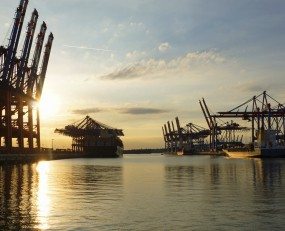
The problems experienced on the Rhine are not new but underline the difficulties that ports face with landside logistics.
Contargo, the Rhine intermodal terminal operator, issued a statement on the 12th of August concerning its river-barge operations, asserting that the water- level had fallen to such a degree that “our barges will not be able to sail without danger, and for reasons of safety we shall have to largely discontinue our navigation on the Upper and Middle Rhine”. Barge operators have made similar statements. Essentially this means that container and other cargo-type operations that normally use the Rhine to access much of western Germany will have to shift to rail and road transport. This is a significant problem but far from unprecedented, as the Rhine has experienced low water levels on several occasions over the past couple of decades.
Barges provide a useful addition to landside logistics for the ports of Rotterdam and Antwerp. Both ports have seen sustained growth in volumes over the past several decades, and this has been paralleled by the development of the additional container terminal, with Maasvlatke 2 being a good example. However, developing landside logistics is less straightforward. The roads in both Northern Belgium and Southern Netherlands are heavily used, which is hardly surprising for such a populated region. New rail capacity has been created to support higher port volumes, but this also struggles to compete for space with local passenger services. The use of barges has opened up the possibility of using large intermodal terminals on the central Rhine, such as Duisburg, bypassing the congestion of the lower-Rhine region. If the capacity of barge traffic is constrained, it will present an obstacle to growth for both port complexes.
Much of the congestion in container ports worldwide is due to landside container logistics systems being overwhelmed by changes in container movement patterns. However, if container shipping continues to grow, the issue of a substantial new infrastructure will have to be built to support it. This will be both expensive and politically difficult in many major port locations. But, of course, it will also be a major opportunity for logistics service providers and investors.
Ti’s Q3 2022 Ocean Freight Rate Tracker provides transparency on current sea freight rates, capacity, congestion and container availability by trade lane, and maps out expected rate development for each quarter and out to 2023. More information can be found on the Ocean Freight Rate Tracker: Q3 2022 Whitepaper published this month.
Source: Transport Intelligence, 16th of August 2022
Author: Thomas Cullen